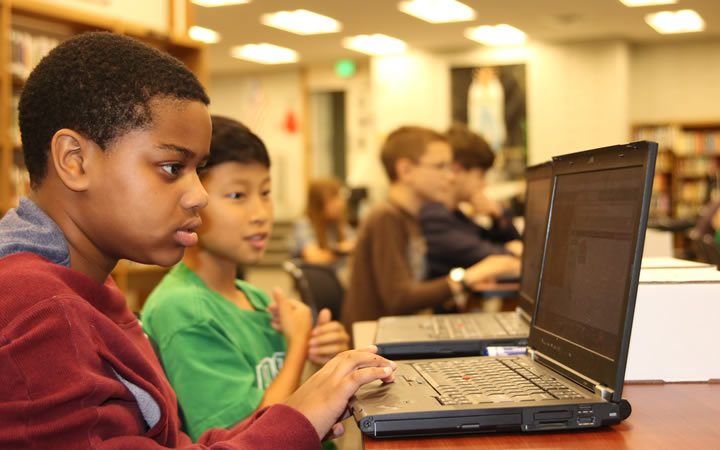How to Survive Your First STEM Lesson
Jenn Taylor, Trustey Fellows Cohort 2 - Clara Barton School in Cherry Hill, NJ

I have always considered myself a lifelong learner, curious about the ever changing world around me. Always looking for ways to improve my teaching, three years ago I applied and became a Trustey Family STEM Teaching Fellow. I arrived on campus ready to work hard and learn. After participating in my first “Integrated STEM Experience,” I left Notre Dame’s campus motivated to bring STEM to my students the way the Trustey faculty brought it to life for all of us. I felt empowered in a way I had never felt before. I was a rock star ready to take on the world!
Fast forward two years, and I have now taught various STEM Integration projects, co-planned lessons for other teachers to implement, co-led numerous STEM professional development opportunities for colleagues, and successfully completed school-wide STEM nights.
Even with two years of experience, I am by no means perfect or the rock star STEM teacher I dream of becoming one day. That being said, I continue to challenge myself, my students, and my school and gain more experience each day. Are my students engaged and bubbling with excitement when participating in STEM? Of course! How could they not be? Are there hiccups and stumbles along the way? Of course! How could there not be? No lesson is ever perfect. Do I always know how my lessons will end up? Nope! And that’s the beauty of STEM. Everyone will be successful, but they will do it ways you never envisioned.
So with this STEM experience under my belt, I have some advice to share with you about how to survive your first STEM lesson.
The Planning Stage
- Plan ahead. There’s going to be chaos when you are doing STEM lessons because there’s a lot going on at once, but with a little bit of planning, this can turn into organized chaos. You need to know what you’re doing and when you’re doing it so you can multitask your way through 7-10 different groups working at various times and paces. Preparing bins of pre-organized materials is a tremendous help.
- Think like a kid. I once tried to do the Ship the Chip Activity and didn’t provide my kids a budget. Although they planned, it became a free-for-all with materials and became more of a building activity than a STEM activity. Initially it was a disaster, but with a little redirection, we got back on track. If I had taken the time to think like a kid, I might have predicted the free building and could have avoided it altogether.
- Ask your kids for materials. I live in a house with five people, and we use a lot of boxes, paper towels, and toilet paper tubes. I can save quite a bit, but it still takes time for me to gather materials. Ask your class or email parents and the school community to help gather recyclable materials. It takes a little bit of planning, but not worrying about having enough materials during the project is truly worth it.
-
"Ask reflection questions with a purpose in mind – what is important for you to know?"Reflect. After attending the Summer Institute at Notre Dame, I realized just how important reflection really is. Make sure to not only have the kids reflect, but to also think specifically about what you want them to focus on. It took me a few STEM lessons to learn what I really wanted to know, and I don’t always want to know the same information after each integration project. Ask reflection questions with a purpose in mind – what is important for you to know?
The Actual Teaching
- Stay quiet. Really, stop talking . . . right now . . . you’ve probably said too much already! Be a supportive coach and an encouraging cheerleader, pushing your students towards success without giving away too much. Sometimes I catch myself, and in my head I’m saying, “Don’t say anything! They need to learn!,” while on the outside I smile and encourage them to figure it out. To those colleagues nervous about tackling STEM on their own, I always joke, “Don’t worry about knowing all the answers ahead of time, you can’t say anything anyway! The kids won’t know that you don’t know!”
- Ask questions. This works well with “stay quiet.” Ask questions, but be careful how you ask them. Think back to how our fearless Notre Dame leaders asked us questions and directed us to the right answer, but make us think it was our own idea. Do that! Also remember: don’t answer all their questions. Sometimes they try to trick you into giving too much help!
- Liven up the environment. Think about how music can set the tone of the classroom and work. Remember when you heard, “it’s the final countdown . . .” when rushing to complete your first integration project. Breathe some life into your kids. I also am constantly timing to keep my students moving at an appropriate pace and to keep me focused. This helps bring a little real world time pressure to the project and keeps the project moving at the right pace.
You Finished
- Hooray! – Celebrate your amazing teaching with a tweet! Don’t forget to tag @STEMatND.
- Reflect – Remember to take time to personally reflect on how the lesson went. What were the things that worked the best? What needs to be tweaked for next time? What can be shared with others?
- Upload on Schoology – I am terrible at this, but be better than me! Upload your work so we can all steal it, I mean collaborate together!
You’re going to be exhausted, like crazy tired, but it’s all worth it! Through your STEM activity, your kids have learned real life skills and were challenged in a way they will be sure to remember.
Interested in learning more about the Trustey Fellows? Sign up to receive more information!


